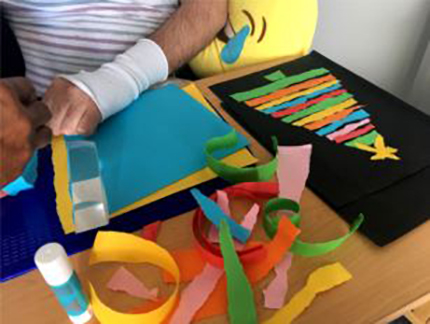Christmas Card making for rehabilitation therapy

Real life events, throw up so many opportunities to do what we ask our clients and their support people to do; to generalise therapy goals into everyday situations. It allows us to model what good therapy can be. There are real time limits, real people, real consequences and real benefits. So it just makes good sense to use these cultural events to help our clients make some great gains. If I’m really honest, its good fun too.
Ok. So enough of the reasoning-rant what did we do? We made Christmas cards. From scratch. I went onto Pinterest and looked for ideas of simple handmade Christmas cards. Nothing childish. All the clients I made cards with had limited use/control of their hands, so a complex creation wasn’t going to work. I also needed the art work to be finished in a single session as a fatigue, attention and time management strategy. And lets face it, the art making part was flat out Occupational Therapy. (O.T.)* I went armed with 2 options for clients to make. I did a practice-run at home, because I was nervous the whole thing wasn’t going to work… But the practice-run provided me with a “here’s one I prepared earlier” finished artwork to show. Win:Win. In the end, the clients all chose the same option; the ripped Christmas tree (which did look rather fabulous).
We took a photo of the artwork for the front cover of the Christmas cards. Then we took a photo of the client holding their artwork. This way it was REALLY clear to people receiving cards, this Christmas card was lovingly made by their special someone.
We worked out a list of people to send the cards to, and talked through how & when those people were going to receive their card; Handed out on Christmas day? In the post (Do you have their address?) We worked out how many stamps were required for the cards to be posted. We counted how many cards we needed to have made.
>We went to an online print company to make the cards up. (Chosen by me according to cost …. If time had allowed, this was another problem solving opportunity, but I didn’t have sufficient time to include the clients in this part of the process.) The clients chose the message they wanted to have on the inside of the card. We Googled “Christmas card messages”. Thanks internet. The clients made decisions about the layout of their cards. Image Here? Text here? How big? What font?
Then 10 days later they got their cards. The tangible results of their efforts. Was it well received? Umm YES. It was one of those times it is really, really rewarding to be a therapist. The clients’ all brimmed with pride when they saw their handiwork. One client, who has difficulty remembering things from day to day IMMEDIATELY recognised the Christmas card as her own work. Goosebump material really.
The clients wrote their messages on the cards according to their level of hand control. One simply signed off with his first initial (which he practiced everyday from the time we generated the cards online to the day he signed them.) A bit like a rock star really. Single letter and all that.
The cards were so gorgeous, I asked one client (and their family) if I could use it as my work Christmas card and sent it to my work network.
Did therapy stop there? Pfff. No. We took photos of the PROCESS of making the cards, and the support workers for each client helped to develop a story in Story Creator. (All of the clients and their support workers knew how to do this without me facilitating it) The story was then (hopefully) used to support communication with family and the next shift of support workers.
Therapy areas targeted:
- Problem solving
- Planning
- Attention & Concentration
- Hand therapy
- Elaboration in conversation (with the story created after the fact)
- Memory (using the Story Creator story)
*If you work closely with the O.T. in your team it would be possible to split the cognitive communication aspect from the hand therapy and procedure of the art creation. Or even to do it as a joint session and have the benefit of 2 clinicians coming at the task from 2 different disciple view points. For my clients participating in this activity, they were not seen jointly due to mindfulness of funding constraints. The Occupational Therapist was completely swamped in equipment prescription and home modifications. After a brief discussion of goals and a few tips, I got the go ahead to be an O.T. assistant for the artwork making.
 Rehab Connection
Rehab Connection 